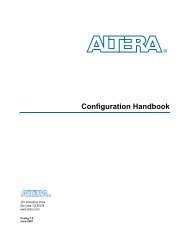Serial real-time clocks (RTCs) with alarm
Serial real-time clocks (RTCs) with alarm
Serial real-time clocks (RTCs) with alarm
You also want an ePaper? Increase the reach of your titles
YUMPU automatically turns print PDFs into web optimized ePapers that Google loves.
Operation<br />
M41T62/63/64/65<br />
2 Operation<br />
The M41T6x clock operates as a slave device on the serial bus. Access is obtained by<br />
implementing a start condition followed by the correct slave address (D0h). The 16 bytes<br />
contained in the device can then be accessed sequentially in the following order:<br />
● 1 st byte: tenths/hundredths of a second register<br />
● 2 nd byte: seconds register<br />
● 3 rd byte: minutes register<br />
● 4 th byte: hours register<br />
● 5 th byte: square wave/day register<br />
● 6 th byte: date register<br />
● 7 th byte: century/month register<br />
● 8 th byte: year register<br />
● 9 th byte: calibration register<br />
● 10 th byte: watchdog register<br />
● 11 th - 15 th bytes: <strong>alarm</strong> registers<br />
● 16th byte: flags register<br />
2.1 2-wire bus characteristics<br />
The bus is intended for communication between different ICs. It consists of two lines: a bidirectional<br />
data signal (SDA) and a clock signal (SCL). Both the SDA and SCL lines must be<br />
connected to a positive supply voltage via a pull-up resistor.<br />
The following protocol has been defined:<br />
● Data transfer may be initiated only when the bus is not busy.<br />
●<br />
During data transfer, the data line must remain stable whenever the clock line is high.<br />
● Changes in the data line, while the clock line is high, will be interpreted as control<br />
signals.<br />
Accordingly, the following bus conditions have been defined:<br />
2.1.1 Bus not busy<br />
Both data and clock lines remain high.<br />
2.1.2 Start data transfer<br />
A change in the state of the data line, from high to low, while the clock is high, defines the<br />
START condition.<br />
2.1.3 Stop data transfer<br />
A change in the state of the data line, from low to high, while the clock is high, defines the<br />
STOP condition.<br />
12/44 Doc ID 10397 Rev 19

















